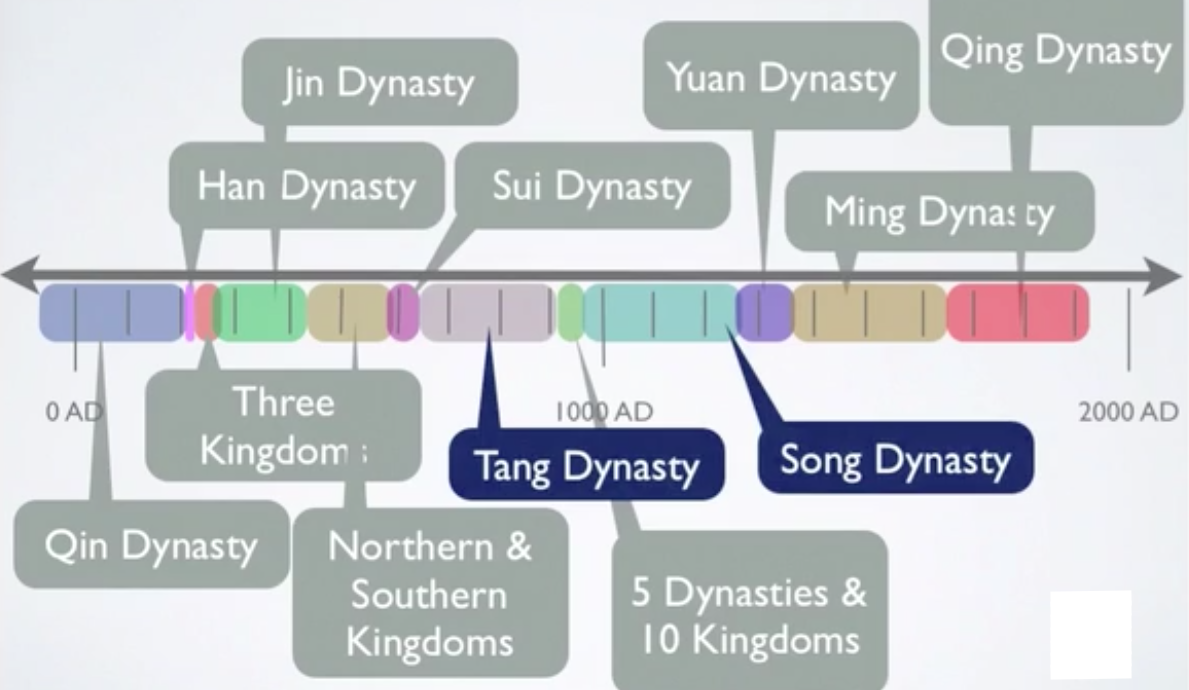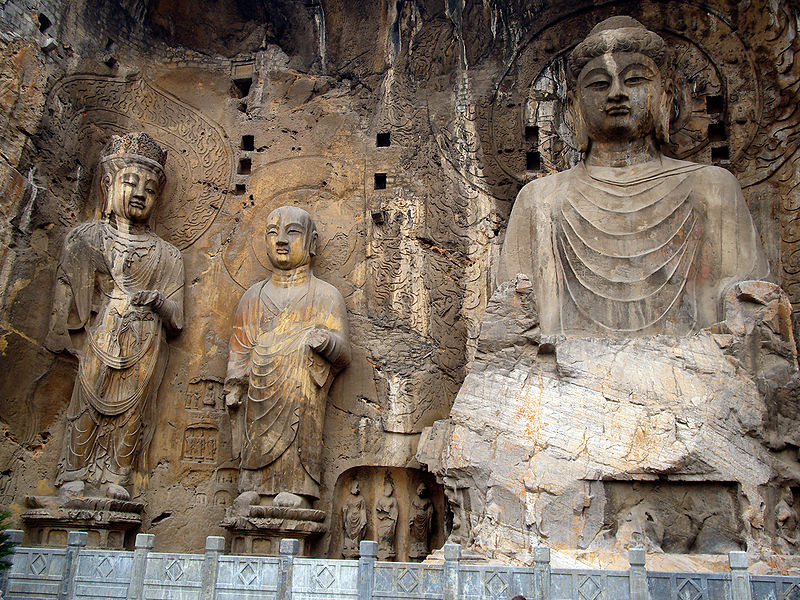Table of Contents |
During the Common Era, China was ruled by a succession of dynasties. This period of time stretched from after 0 AD to the early 20th century.
Below is a timeline highlighting a partial list of some of the ruling dynasties during this period.

Note that this is not a definitive list by any stretch, but rather an outline. Some of the dynasties on this list may stand out to you, such as the Qin Dynasty, which is where the word “China” derives from. It’s the first one on the left. The Ming dynasty is known for the production of the white and blue porcelain vases that are named after it.
In this lesson, you will explore the art and architecture from two periods shown on the above timeline in blue: the Tang dynasty and the Song dynasty. The Song dynasty itself is actually broken up into two parts, the North and South.
China is a country that, along with Russia to the north and India to the south, comprises the majority of the Asian continent. Two locations covered today are Luoyang, China, and Foguang Pagoda, just a bit northeast. The Silk Road, which was named after one of the primary goods traded via this route, is shown on the map below. It was one of the most important means of cultural exchange throughout Asia as well as between Eastern and Western cultures. It actually passes right by the city of Luoyang.

The Tang dynasty succeeded the Sui dynasty and successfully reunited a broken China. The Tang dynasty subsequently became one of the most important periods of Chinese cultural development. It was also a time when Buddhism was the primary religion throughout China, and there was a proliferation of art with Buddhism as its theme.
The Longmen Caves are located in Luoyang, China, and feature sculptural relief that spans almost 1,000 years. In this lesson, you will explore some examples of monumental sculptural relief, specifically the Vairocana Buddha.
The Vairocana Buddha is one of the largest, if not the largest, sculptures of the Buddha, and it resides within an even larger, complex assortment of Buddhist iconography in these caves. “Vairocana” means “illuminator,” and depicts the large figure of the Buddha in a lotus, or meditative, position.
Below is an image of the Vairocana Buddha, created during the Tang Dynasty, 618 CE to 907 CE.

618-907 AD (Tang Dynasty)
Luoyang, China
In the above image of this triad, Buddha is on the right. He is flanked by Bodhisattvas and disciples who, in typical hierarchic scale, are smaller but still colossal in size.
Buddhism is a religion that is composed of different branches, all of which share a similar foundation and ancestry. Zen and Pure Land Buddhism are two of these branches. Unlike Zen Buddhism, adherents to Pure Land Buddhism believe that enlightenment cannot be achieved on your own but only through faith in a form of Buddha called Amida Buddha. Pure Land predates Zen Buddhism by about 350 years, and arose during the Tang dynasty, quickly gaining a strong following.
EXAMPLE
Below is an image of the Paradise of Amitabh:
The above image is a 9th century painting in Dunhuang, China, a major stop on the Silk Road that consequently became a major site of Buddhist art. This is just one of many cave paintings at this particular site. This painting is interesting in how it depicts the Pure Land as consisting of Tang dynasty imperial architecture, which is a definite nod to the style of the time, but also the very honest and human depiction of paradise as something familiar, something like home.
It is important to think back to the idea that the veneration of sacred relics is an important part of Buddhism. The Chinese pagoda is a type of shrine that was developed, like the Indian stupa structures that preceded it, to house sacred Buddhist relics. The relics were housed under the foundation floor of the pagoda in many cases, sealed off from the rest of the structure, which also functioned as a Buddhist temple that could be entered, unlike the Indian stupa.
The pagodas were wooden structures and featured many innovative design elements, such as the post-and-lintel variant called dougong, which is a form of Chinese roof bracketing.
EXAMPLE
Here’s an example of dougong from a Japanese structure:
Unlike many types of structures, the walls within the pagoda are not load-bearing. Instead, the weight of the roof structure is channeled through massive vertical columns by way of the dougong. Layers of wooden beams are laid perpendicular to each other and cantilevered over a supportive column.
EXAMPLE
Take a look at the image below. This is a simple example of this structure.
If you can imagine here, those little gray blocks are supposed to be going back into the picture running perpendicular to the blue block. You can see how this rather ingenious method allows for portions of the structure to be extended outwards, and allows for a surprising amount of elasticity in earthquake-prone areas, something with which stone structures are notoriously poor.
The Foguang Si Pagoda in Shanxi Province in China is a Buddhist temple and shrine. At about 216 feet tall, it is the tallest wooden structure ever made. It was constructed in 1056 during the Northern Song dynasty, and it is an octagonal design with column supports in the corners of that octagon. This structure is symmetrically balanced and supported by the use of 60 giant, four-tiered brackets that hold the structure together.
EXAMPLE
Here is an image of the Foguang Si Pagoda in Shanxi Province in China:
If you look at the walls or the sides of the octagon, you will see that these were not load-bearing. Actually, all the weight is channeled into the columns that you can’t see, that are in the corners of the octagon.
Source: THIS TUTORIAL WAS AUTHORED BY IAN MCCONNELL FOR SOPHIA LEARNING. Please see our Terms of Use.